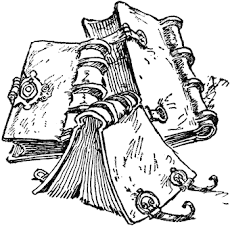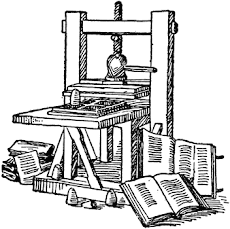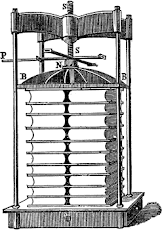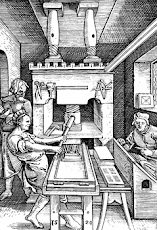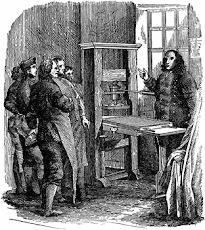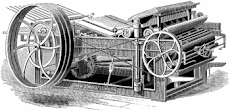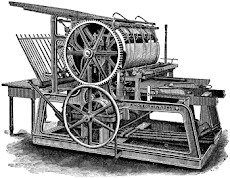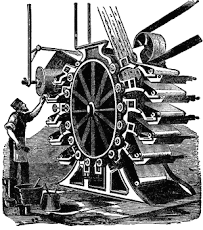
Introduction
The development of printing and its rapid spread throughout Europe is the story of an astounding rate of social change, greatly influencing the historical developments within the political environment of the time. The social consequences of a shift of religious and national ideas, the economic outcomes of this new invention to society and the individual, and the scientific developments that made the printing process possible changed the world dramatically. This essay is a brief story of these developments over the centuries from 1450 to the dawn of the twentieth century.
Gutenberg - his life and times
Johann (sometimes spelled Johannes) Gutenberg, the inventor of the movable-type printing press from Mainz, Germany, is an interesting study of a man of the mid-fifteenth century Europe. From his family of coin makers, he learned of the art of metal-smithing, punch-making, mold-making, etc. In his thirties, Johann moved from Mainz to Strasburg, and became secretive of his work. He was well off, but not rich or aristocratic. He had gained enough money to spend his time on his work, even though a financial crisis had hit the area, especially the city of Mainz.
Eventually he had three partners. During the time of this process one of the partners died, and he and the other partners were worried that it might cause their work to become known, and they took precautions to stop anyone finding out. This is an intriguing part of the story. Apparently Gutenberg and the remaining two partners succeeded in court against the dead man’s brothers’ lawsuit. They wanted in on the business deal their brother had been involved in with Gutenberg. Luckily the business partners had all signed a binding contract which stood up in court. This was very fortunate, according to John Man, author of The Gutenberg Revolution, as the two brothers were vexacious characters, and in fact sued each other later over their brother’s estate.
The partnership was originally set up for them to make money selling amulets, small metal hand–held mirrors, to pilgrims at a cathedral 250 kms away, at a religious festival held every 7 years. It was Johann’s idea that the business partners were initially backing with their capital. Johann’s family had been involved in the minting of coins, so although Johann had not worked in the mint, he was familiar with blending metals, creating intricate designs in the dyes to produce coins, and the making of presses.
They were set to rake in the dough on these religious objects. At that moment though, the plague, which had been in its height around the 1340-50’s, was threatening to return, so the festival was postponed for a year. Nevertheless, this project helped Gutenberg hone his skills, and probably kept him financially afloat.
He moved back to Mainz due to civil unrest in Strasburg, and rented a house to set up another printing workshop, made possible mainly because of a loan from Johann Fust.
His movable type printing press was further developed here, and historians agree that his work was the invention and perfection of a craft of exceptional beauty and detail in every aspect of the process. Johann Gutenberg displayed the talents of a patient master craftsman, artist, and businessman, able to inspire his workers to the same standards of excellence to which he strove. The superb quality of his ‘Gutenberg Bible’ indicates this.
After a few years, as he developed his workshop, he decided on the idea of printing the Bible. The church at this time was very interested in standardizing their sacred books. Gutenberg needed to create a popular product to pay back debts, as he had now borrowed again from Fust and opened another printing workshop in another rented house. At this point the invention was no longer secret, and Gutenberg and his team produced other printed works while working on the elaborate and time-consuming Bible project.
There are moments in history where knowledge and thus civilization takes a giant leap forward. The first moment was the creation of language, the next was the devising of symbols to communicate across space and time, with the ability to archive information. The next quantum leap was the invention by the Phoenicians and the completion by the Greeks (by adding vowels) of the alphabet, when words could be written as they sounded, not as a symbol, which had kept writing somewhat secret and elite. The next leap forward came with the invention of the printing press. The invention of the computer, and more importantly the personal computer propelled us into a 'brave new world' of technology for all. Just think that in 1990, we had fax machines and photocopiers and that’s about it. To think that 20 years later none of us can conceive of living without a computer, an astounding leap in the technological advancement of communication.
From my reading I perceive that Gutenberg was not a particularly savvy businessman. He didn’t even manage to pay the interest on his loans from Johann Fust, and Fust took Gutenberg to court virtually on the eve of Gutenberg turning a profit on his Bibles. They were already in print and the printing presses were rolling daily to produce more. Fust was awarded the workshop and contents of the building that housed the Gutenberg Bible presses etc. It was Fust who ended up distributing the Bibles, while Gutenberg retained his first printing house and business. Fust’s adopted son, Peter Schoeffer, confused history for a while by claiming Fust had invented the movable type printing press.
The rumblings of discontent were already being heard in the Germanic regions against the Catholic Church based in Rome, and the Church and townspeople of Mainz warred with each other in 1462, one of the first rebellions against the authority that the church imposed on the Germanic people. Gutenberg along with many others of the town were thrown out, losing their properties to those who had backed the Pope and local archbishop. Gutenberg moved to Eltville and kept printing. The ousting of the citizens of Mainz had the effect of scattering those printers to other towns who started printing presses where they landed, beginning the spread of the craft far and wide.
The Printing Press Expands Across Europe
Statistics tell the incredible story. In 1450 all of Europe had approximately 100,000 books. By 1500 it had 9 million. By 1480, only 30 years after Gutenberg still was sweating over his new invention, Venice was the leading printing town of Europe, with as many printing presses as Germany. Anecdotally, Italian printers were now training Germans in the art!
Also around this time, after 1453 when the Turks invaded and took over the Byzantine capital of Constantinople, a migration en masse of Greeks, including learned scholars, brought the Greek and Roman classics to Venice.
An enterprising printer Aldus Manitius seized on the entrepreneurial goldmine of making Greek typeface and printing the Greek classics. His work was of a high standard. Aristotle in five volumes was the first to be printed in 1495-98. The translation of the Greek Bible did not exactly match the western European text, another point of religious discussion for that age.
This thirst for knowledge and understanding, now that the knowledge of the middle ages had been turned upside down, created the expansion of the Renaissance which historians consider began with the fall of Constantinople.
Jensen, who was a French ‘spy’ sent to Germany to find out about the new invention, but who stayed on to perfect his knowledge of printing, later moved to Italy. He created the typeface of the Roman lettering in 1471, in the first printing of the Bible in Italian. The clarity of this form of the alphabet made reading much easier than the German Gothic style which followed the lines of the written script of the times in Germany.
This period, 1450 to 1500, was known as the Incunabula, the ‘incubation period’ of the development of printing. The details of this history give us an idea of the sophistication of the society of the time, and their intelligence and curiosity about their world.
From Germany and Italy printing presses multiplied across Europe, bringing knowledge to anyone who could read. William Caxton printed books in English in the 1470’s, standardizing the English language as never before, and brought ancient classics and English literature to the people of England, the tip of the vernacular iceberg sweeping across the continent, irrevocably altering society.
Improvements on the printing press continued right up to the present day, slowing improving on speed, accuracy and quality. Issues such as copyright, which previously had not been considered when books were lent to each other by individuals, institutions, scribes and book publishers to be copied by hand.
The first copyright law to be enacted was the Copyright Act of 1709 in England. Other countries followed suit soon after.
The Reformation
The Catholic Church at first loved the printing presses. Gutenberg's Bible was part of a movement to standardize the writings, prayer books, etc. so that all of 'Christendom' was on the same page, so as to speak.
The church had ’indulgences’ printed by the new movable type printers, and this meant they could print lots of them. People bought ‘indulgences’ as a way of buying themselves or a loved one (even if they were already dead) out of purgatory and a ticket straight to heaven.
Eventually a young monk named Martin Luther, in the early 16th century, questioned the ethics of money being able to buy off any ‘bad karma’ you had created. The change in society was that now people were actually reading the Bible, unlike 50 years ago, when not even all priests or monks or nuns were familiar with the contents of the whole Bible. It had been written in Latin and there were limited copies available to those who could read Latin well enough to understand it all. Society at large was starting to understand Christianity in a new light, in their native language. It became known that you were responsible for your own actions. This caused a lot of debate on whether we had free will or whether our actions were predestined.
Luther visited Rome and discovered the place seething with debauchery, packed with prostitutes servicing priests and monks, and a pope who believed in taking advantage of his position with an opulent and debauched lifestyle. Luther was horrified at what he saw, and from then on did not respect the authority of the Pope. His reform proposals, which legend has it he pinned on the church wall, were sent by him to the Pope, but leaked (to the press, the printing press that is). Everyone started to question the buying of indulgences at that point. This was bad for the Catholic Church which was relying on these resources to pay for war against the Turks in Cyprus, and to finish St. Peters Cathedral in Rome.
This video gives an excellent history including the circumstances in Europe which lead to this moment of change.
Luther’s ideas spread like wildfire, due in great part to the printing presses. Although initially horrified that his reform petition to the Pope had become public knowledge, he stood up to a council of the Pope’s representatives, reiterating his beliefs, and, on the way home from that event, was fortuitously kidnapped by friends before his enemies could do him in, and hidden in a castle for a few years. Sequestered as he was in the castle, he set to work translating the Bible into German, which he subsequently printed.
The vernacular Bibles brought knowledge to regular people, many of whom were the growing merchant and trading class who were becoming more literate, informed, and a growing political force. Luther kept printing his radical ideas for his whole life. The Reformation was in full swing. Much of northern Europe became disenchanted with and broke away from the Catholic Church. The Lutherans, as they were called, were still quite conservative. Many more protestant churches emerged which began to fight about beliefs among themselves.
The Catholic Church launched the Counter Reformation, cleaning up their church of the gross corruption, with a pious Pope who behaved like a true Christian, living simply and giving to the poor. Also they standardized and printed the prayer books so that it was consistent across Europe. At about this time the Jesuit monastics started opening schools, and as they educated the children of the rich and powerful, their influence helped to stem the protestant tide, which stopped expanding.
The creation of the Church of England by King Henry VIII was a political blow to Rome, though this new church was still quite conservative. The Bible had been translated into English quite early, in the 14th century, but the printing of the Bible into English in the 1520’s by William Tyndale opened the door to discussion of Christianity’s beliefs there. Tyndale had to smuggle the books into England after they were printed in Germany, and the more the Church of England railed against these printed English Bibles, the more sought after they became! They were a hot item on the black market! The Bibles were burned, but more arrived to take their place. The writing was on the wall, and the authorities wanted consistency of translation. The King James Bible was the first authorized and standardized English language Bible to be printed. A new dawn had emerged all across Europe, where the questioning of ideas gave rise to a fertile intellectual life.
I haven't mentioned the Inquisitions which, incidentally, were begun in Spain to persecute the Jews and Muslims, many of whom migrated back to the Middle East, bringing European ideas and culture with them, including the printing press. There was a lot of fighting, killing, and burning of heretics during this turbulent time. Besides the great loss of life in the name of religion, the saddest part about the reformation I found was the wholesale destruction of church art and sculpture as the ‘puritans’ destroyed the symbols of idolatry in the Catholic churches. One can understand the anger of Catholics in the light of this uncivilized behaviour.
The Renaissance
To look for the roots of the renaissance we need to go back in time a bit here, to Cassiadorus, and St Benedict, both of the C6th, who were largely responsible for saving the writings of ancient Greece and Rome in Europe, by going to monastic libraries and saving the old manuscripts that were rotting in the deteriorating monasteries of the time. The Benedictine monks diligently copied these classics as well as the work of St Augustine, Jerome, Gregory, and other early church fathers.
The Carolingian (Frankish) Empire (C8th) had a great interest in the preservation of the classics as well. In Byzantium the Greek and Roman classics were preserved, as they were in the Middle East and Moorish Spain.
As city-states developed, literary work was beginning to be translated into vernacular languages. The merchant and tradesman classes began to get prosperous and have more influence, the feudal system gave way to a more modern type of state with commerce as its base. International trade began to influence social concepts.
The rise of university towns from 1200AD saw secular clerics producing books for the students. Before that mostly it was the monks who were scribes. The effects of the new universities were cumulative and ultimately led to the renaissance. There was an interest in secular subjects as well as theological, including the studying of the ancient texts of Greece and Rome.
Bookmaking (manuscripts) and book-selling from 1400AD especially in Venice, Florence, Paris and Frankfurt became a commercial enterprise.
Woodblock printed (known as xylography) books were being printed, usually picture books with more and more text being added over time to describe the story.
Add to this mix the genious of Gutenberg’s invention of movable type, with the ability to create the adjustable metal molds that could cast different sized types accurately and in large numbers. The stage was set for the dramatic changes that swept over Europe at that time.
A pre-renaissance had started in the early C14th but the plague which spread across Europe in about 1350’s, killing at least one third of the population, stalled this process.
Lorenzo de Medici was a prominent example of the growing wealthy and secular merchant class. His family wealth came from his family’s banking business. He was a great patron of the arts in Florence in the 1400s, and, for example, was Michaelangelo's initial patron. He introduced Michaelangelo to the Humanists and intellectuals of the day who met at Lorenzo's palace to discuss the new paradigm of Humanism that was emerging from the renewed interest in the philosophies of ancient Greece and Rome coupled with growing understanding from scientific inquiry, and the knowledge gained by travel to foreign lands as trade flourished.
Michaelangelo was a true renaissance man, excelling in painting, sculpture and architecture. He even designed a library! Giulio de' Medici, who had by this time become Pope Clement VII, commissioned the creation of a great library to house the vast Medici collection of books. The design, particularly that of the library's vestibule, is one of Michelangelo's greatest architectural achievements. Its main feature is the spectacular staircase, the idea for which came to Michelangelo in a dream. Read more about Michaelangelo's architectural designs and constructions.
Architecture was being influenced by ancient Greek and Roman styles and proportions, art was becoming more realistic. Michaelangelo and Da Vinci were working in Florence in the late -1400’s- early 1500’s. It was the fall of Constantinople in 1453 that was the spark that propelled Europe into the Renaissance. While the Greek scholars poured in to Venice and other Mediterranean countries, bringing their scholarly manuscripts with them, the printing boom was about to hit Italy. The printing of these classics by Italian printers made the information widely available.
The free thinking of this time lead to the flowering of art, architecture and philosophy of the Renaissance, which coincided exactly with the flourishing of the printing press in Italy. By 1500 the Greek and Roman classics were being printed and widely read. New ideas were brought into the consciousness of Europeans.
In the 1400s, the Humanist movement had emerged based on the classical teachings of the inherent goodness of mankind, the respect for nature and scientific enquiry, and more enlightened ideas of man’s place within the world of nature. The Humanists were not enamored of the Reformist movement which placed even more restrictions on people and holding on to the idea that we are sinners whose life is basicly for repentance. The Humanists rejected this negative view of humanity and praised the natural world and man’s place in it.
The printing of books, spreading like wildfire across Europe, brought a huge wave of new ideas and ways of perceiving the world. Secular books, art, and art prints, flourished. Without the printing press, the Renaissance could have affected Europe much less. It was this availability of knowledge to everyone which spurred the rapid changes.
This video gives a good overview of the renaissance and the resulting changes to society.
Paper
The discovery of the paper-making technique created huge changes as the quality of the product improved to be competitive with vellum. It had come from the Chinese via the Arab civilization to Europe by the 12th century. Paper was first made in Fabriano, Italy, then the process spread to other Italian cities and then across Europe. It was made from rags, hemp and flax.
The best quality was from Italy, but France became the best producer, and later, around 1700, Holland. The paper used for the Strasburg area (Gutenberg, Fust and Schoeffer etc.) Incunabula (as the first movable type books of pre-1500 are referred to) bear French watermarks. Paper mills grew in number as printing presses did. At one point there was a scarcity of rags, and laws prohibiting export to other countries were sometimes put in place to assure a supply for each country’s own paper mills.
Paper was much better suited to printing than vellum. By 1400 paper was a common commodity, and had taken over from vellum, but vellum and manuscript writing still prevailed for a while even after the invention of the printing press. Print was seen as a bit lower-class at first. The aesthetics and durability of manuscripts on vellum were still valued.
As an example, paper mills were set up in Britain, mainly by Huguenot refugees (protestants escaping persecution in Europe) and by the late 1600s Britain had one hundred. In Germany by the late 1700s there were 500 paper mills.
Printed books were made to look like manuscripts at first. The art of printing was constantly developed through the creation of beautiful fonts, illustrations, and the development of the art of bookbinding.
Woodblock printing, xylography, was already in use by the 13th century in Europe (from the influence of Asia), they were usually illustrations, pictures, and often of the saints or scenes from the Bible. With an illiterate population pictures were a means of passing on information, and the pictures were also used as amulets. The illustrations came to incorporate text to tell something of the subject, and after a while the text expanded. Block prints were in the vernacular languages, and began to be made into small books, which were still being produced after the printing press.
The themes became more secular. The development of playing cards started at this time. They were printed in black, then hand-painted, as were many block-prints. Satirical posters, business forms, and calendars began to appear.
To beautify printed books, these woodblock prints were added, and this art developed into copper engravings which could give more subtle and detailed renderings, and was better suited for use in a printing press.
Interestingly, because of the early travelling printers who spread out from Germany into other European countries, the art of xylography was distinctly German in style, which was influenced by the style of the various regions into which it was introduced.
Paper made of wood helped to accelerate paper production from the early 1800's, as the raw material was readily available, not a limited supply as rags were.
The sheer amount of industry involved in paper-making is a small piece of the Industrial Revolution that swept the world. There was a backlash to all the mechanization on paper-making and printing, and craftsman such as William Morris brought back the art of hand printing on handmade paper as an art-form.
Metallurgy and typefaces
The design of the metal mold that created the movable type is considered by some to be Gutenberg’s greatest contribution, allowing type to be accurately cast in different sizes and in large numbers. This was the technological breakthrough that made it all possible.
Typefaces at first followed the way handwriting had looked, but by 1470, Jensen, a master printer previously mentioned, made changes to the roman typeface that was beginning to be developed in Venice, developing a typeface that was easily read. (He then also developing ‘Italics’ a sloping typeface which could accommodate more words to a page, and somewhat resembled writing.)
The roman typeface slowly gained popularity. It was based on the ancient Latin script, and also influenced by the Carolingian (C8th) script. "Carolingian miniscule was revived during the Renaissance and has survived as our lower case letters (the capital letters come from ancient Rome”. The Carolingian, or Frankish, Empire of C8th preserved the Roman and Greek classics, and also translated some works into the vernacular.
The Humanists preferred the roman script for their books. Generally the gothic script persisted in scholarly and legal works, and also in Germanic areas where it was better understood than the roman type. For instance, Martin Luther’s first printings were in roman script, but later he used gothic as that is what the surrounding northern European population was familiar with.
But by the year 1550, almost all books were printed with a form of roman script, for its ease of readability. The new roman type of print soon took over Europe, and the older Gothic style we see in Gutenberg’s work became obsolete.
Throughout the centuries, master craftsmen have created typefaces that they considered aesthetic, and my understanding now is that the art of creating a beautiful and functional typeface was painstakingly developed by artistic craftsman of exceptional ability.
As cast letters wore out, metal craftsman were constantly either adding to the typefaces at a printer’s workshop, or creating new typefaces. The alloy of metal used to make the cast letters and the matrices (molds) was a combination of lead, tin, antimony, copper, and iron. It took great skill to mix these metals in a satisfactory way in order to produce a consistent and lasting product. They were constantly experimenting to get the best mix for clarity and durability.
The typefaces developed are names we see every day on our computer font types, for instance Garamond, Baskerville, Bodini, Italic, New Roman.
Development of public libraries
National libraries developed at first as reference libraries. The right of deposit of one copy of every item printed in a country to the national library ensured the rapid expansion of national libraries in Europe and Britain. For instance the Biblioteque Royale of France had 6000 titles in 1622. By 1720 it had 80,000 printed volumes and 16,000 manuscripts. Libraries were opened to the general public only after 1800.
The national libraries acquired books by buying whole private collections, sometimes acquired books as the spoils of war, and also acquired the libraries of monasteries that were closing down. In England under Henry the 8th, the seizure of Catholic assets included their libraries.
In the French Revolution, the libraries of fleeing nobles ended up at the Biblioteque Nationale, as it was then named. Unwanted volumes were sent to regional libraries.
England suffered a huge loss when there was a burning of books by censors around 1500-1550, even items from Cambridge and Oxford University libraries, which was a cultural catastrophe. Bodley revived the Oxford library beginning by donating his own collection, and leaving further funds to it after he died. That’s why it’s still known as the Bodleian Library.
The destruction of books by the Nazis if they were pro-communist or anti-Nazi, and later the destruction of work that was anti-communist and pro-Nazi by Russia are examples of the obstacles libraries have faced over the centuries. Whole libraries were destroyed during WW1 and WWII, though important works were sent to country locations and saved across Europe and England.
The printing industry changed the nature of libraries forever. Books became cheap enough that they could be lent out to the public. The huge amount of printed matter expanded the libraries exponentially. The general public was now literate and able to read, in their own language.
In Conclusion
The invention of movable type printing had massive influence on society, and the effect was monumental. The proliferation of printing presses, paper mills, the growth of public libraries, and the availability of knowledge changed virtually every aspect of life, especially in Europe and Britain, and from there slowly influencing the entire world.
The development of metallurgical knowledge had far reaching effects on industry and inventions.
The printing of laws and regulations led to the masses understanding the mechanism of government, standardized legislation, and lead eventually to democracy.
The Humanist ideas of secular scholars saw man as noble, and a part of the natural world. The beginnings of the understanding of environmentalism were sewn at that moment, whereas before that humans thought they were here to dominate nature while exorcising their original sin! (some still believe it!). The Humanists inspired philosophical and scientific inquiry as opposed to the Catholic Church's authoritative stance. The availability of so much knowledge broadened the minds of all readers. The logic of scientific process tended to negate the superstitious beliefs of the masses, and society applied these principles of logic to philosophical issues.
Science grew in leaps and bounds through the building up of knowledge through being able to read what others were doing even if they lived hundreds or thousands of miles away. Also each generation could build their knowledge by ‘standing on the shoulders’ of the previous generation.
Exploration was helped by the printing of more and more reliable maps, as well as printed travelogues which taught people about geography, anthropology, and science.
Knowledge became an affordable commodity unlike the middle ages where it was a luxury of the upper classes. This has forever changed the balance of power from an elite few to the direct influence of the citizens of each country. The previous level of ignorance before the printing press, the almost total illiteracy of the majority of people, is almost unimaginable today. The consequences of the common person being able to read and have reading materials available are incalculable, changing the very nature of thought and decision-making forever. Every technology benefited from the availability of knowledge in each field.
The need to find better, faster, more economical ways to print, to make paper, and to cast typeface accelerated invention of these processes. The proliferation of readers and authors, of both fiction and non-fiction, engravers, cartoonists, journalists, librarians, printers, typesetters, paper makers, ink-makers, booksellers, etc. created a general upsurge of employment in these areas, usually in large towns or cities. The nouveau riche became patrons of artists, as well as creating more markets for goods and services, and this modernization of society turned the status quo of the church-based culture of the middle ages upside down.
The printing of music gave musicians an unprecedented access to the works of great composers, so that musicians and composers could study these printed music scores and learn from them, inspiring both more music and innovative composing, and the distributing of new works.
The Ottoman Empire from Istanbul to the east and from the Balkans to Egypt, was a fairly enlightened society for its time, for instance having religious tolerance. But the Turks and Arabs banned the printing of books in Turkish or Arabic. This civilization showed little interest in other cultures outside their borders, and only paid attention to innovations in the military and naval fields. Many Turkish officials were illiterate.
This disinterest in and suppression of new knowledge and inventions and ideas caused the Middle East area to fall behind Europe in development for centuries. It was the French influence in Egypt in the 1800's that changed this, beginning printing in Arabic and Turkish, and a secularization and modernizing of Middle-Eastern culture started from there.
The balance of power was now in the hands of the Europeans who had been continually inventing new technologies as well as new political systems, while the Ottoman Empire had been ‘intellectually stagnant’. You can see the consequences of this backward policy of the Ottoman Empire impacting world politics even today.
Resources
Books
Claybourne, A 2008, The Renaissance, Time Travel Guides, White-Thomson, Lewes, East Sussex.
Febvre, L and Martin, H J 1997, The coming of the book, Verso, London.
Gibb, C 1986, Spotlight on the Reformation, Spotlight on history series, Wayland, Hove, England.
Johnson, E D 1970, History of libraries in the Western world, Scarecrow Press, Metuchen, New Jersey.
Man, J 2002, The Gutenberg revolution, Hodder Headline, London.
Mansfield, P 1991, A History of the Middle East, Viking, London.
Mullins, L 2007, Inventing the printing press, Breakthrough inventions series, Crabtree, Melbourne.
Websites
Knox,E.L. Skip, Carolingian handwriting, History of Western Civilization, Boise State University, Idaho, USA. viewed 1 May 2010.
http://www.boisestate.edu/courses/westciv/charles/16.shtml
Roman typeface, Encyclopedia Britannica Online, viewed 1 May 2010.
http://www.britannica.com/EBchecked/topic/507251/roman
Printing press, Clipart ETC, Educational Technology Clearinghouse, Florida Center for Instructional Technology, College of Education, University of South Florida. Last update: 10/12/09, viewed 1 May, 2010.
http://etc.usf.edu/clipart/mysearch.php?searchWords=printing+press&mySubmit=Search
Renaissance, Encyclopedia Britannica Online, viewed 5 May 2010.
http://www.britannica.com/EBchecked/topic/497731/Renaissance
Reformation, Encyclopedia Britannica Online,viewed 20 April 2010.
http://www.britannica.com/EBchecked/topic/495422/Reformation
History of publishing, Encyclopedia Britannica Online,viewed 2 June 2010.
Ruehring, L M, Michaelangelo Buildings, HowStuffWorks, Discovery Communications, viewed 5 May 2010.
http://entertainment.howstuffworks.com/arts/artwork/michelangelo-buildings6.htm

